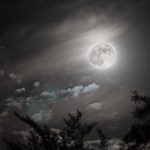Abiogenesis
Posted to the homepage on August 11, 2013.
The Moon—like the sun, stars and Earth—is easy for a human being to take for granted. But the Earth's moon is truly exceptional, and should be appreciated for shaping the exceptional world we live on. Earth is the only planet with a single moon, and relative to the Earth, Luna is the largest moon in the solar system. The Moon thus exerts a strong, solitary influence on the planet it was torn from. Evidence suggests that the Moon was blown into orbit by a massive asteroid impact about 4.5 billion years ago, shortly before the…
"Everyone is a moon, and has a dark side which he never shows to anybody." -Mark Twain
Back before the telescope was invented, Saturn was known as the Old Man of the Skies. The slowest-moving of the naked-eye planets, it's the only one that would reliably be in nearly the same location, year after year. You can find it all summer, after sunset, by following the "arc" of the handle of the big dipper all the way until you run into the brightest northern-hemisphere star, Arcturus, and then speeding on to the very bright Spica. Saturn is right next door.
Image credit: EarthSky.org.
But…
I was thinking about the timeline that brought us here, today, from the origin of the Universe up through the present day. I realized that the most uncertain thing that we know of, the step that we have the least information about, is the origin of life on Earth. All hypotheses about how life on Earth originated fall into three categories:
Abiogenesis, or the idea that life came from non-life, somehow, on Earth.
Life originated elsewhere in the Universe, and was brought to Earth, where it now thrives (e.g., panspermia, or exogenesis).
Life was created or designed by an outside force/being…

